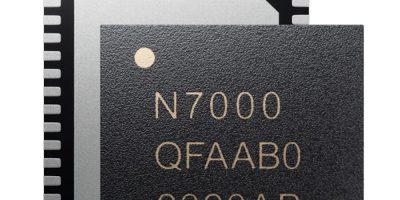Wireless device design expertise gained by STMicroelectronics is combined with its STM32 architecture in the new STM32 SoC which has low power operation and multi-protocol support.
The microcontroller simplifies wireless system design for diverse use cases including metering and monitoring devices in smart buildings, factories and cities, said the company. It is characterised with power-saving features which enable the extension of battery life in the new wireless microcontroller of more than 15 years.
The STM32WL3 wireless microcontroller is designed to be used in remotely deployed applications including metering and monitoring devices and data from alarm systems, actuators, and sensors in smart buildings, smart factories and smart cities. It can help limit power consumption and prioritise activities to improve user experience, service delivery and to reduce the environmental footprint, explained ST.
This is the latest in ST’s lineup of integrated wireless chips. The STM32WL3 contains an advanced, power-efficient multi-protocol radio suitable for long range communication and using license-free frequency bands reserved globally for industrial, scientific and medical (ISM) applications.
The long-range radio on the STM32WL3 microcontrollers operate in the internationally designated license-free frequency bands, 413MHz to 479MHz and 826MHz to 958MHz, with the support for 169MHz coming in 2024.
In addition to the main radio, ST has integrated a low power radio and the system can power down to save energy while listening continuously for a wake-up signal.
The radio is multi-protocol and multi-modulation capable, supporting 4-(G)FSK up to 600kbit per second, 2-(G)FSK, (G)MSK, DBPSK, DSSS, OOK, ASK modulation schemes.
The STM32WL3 microcontrollers can add value to smart connected devices, for example to reduce power and add long range wireless connectivity to existing networking products, as is the case with Lierda which uses the microcontroller’s wake-up radio to minimise power consumption, while the Lierda module monitors and maintains network equipment across a point-to-point or point-to-multipoint wireless connection.
Another customer, Silent Smart Technology, has created a family of modules based on STM32WL3 wireless mictrocontrollers that operate in various sub-1GHz frequency bands. The modules support multiple transmission modes, channel monitoring, wireless relay and other functions. The wakeup feature allows the modules to operate in deep-sleep mode, consuming only about 1microA overall current while remaining ready to return to full operation.
Benoit Rodriguez, wireless business line general manager, STMicroelectronics, said: “Special features such as the wake-up radio and our flow-metering LC sensor controller enable energy-saving designs in smart metering, smart agriculture, and asset tracking that run for up to 15 years from a small battery.”
The radio is multi-protocol and multi-modulation capable, supporting 4-(G)FSK up to 600kbit/s, 2-(G)FSK, (G)MSK, DBPSK, DSSS, OOK, ASK modulation schemes to maximize versatility and ease deployment.
On-board peripherals include an LCD driver, a 12-bit 1Msample per second ADC, analogue comparator, DAC and multiple timers. Together with an integrated balun, RF power amplifier and switch mode power supply, they minimise external bill of materials (BoM) for a cost-optimised solution with short time-to-market, said ST.
Tailored to the specific needs of smart-metering applications, the STM32WL3 embeds an LCD controller and a specific peripheral – LC sensor controller – for fluid flow measurement. The multi-protocol support enables cost-efficient deployment of one single platform over different long-range wireless technologies, including Sigfox, KNX, mioty, M-Bus said ST.
The complete lineup in the STM32WL3 series contains devices with Flash density from 64kbyte to 256kbyte and 16kbyte or 32kbyte RAM, in a 32-pin or 48-pin VFQFPN package. There is also an extended temperature range option, from -40 to +105 degrees C.
All variants are covered with ST’s 10-year longevity guarantee for industrial products. Sample quantities are available now.







